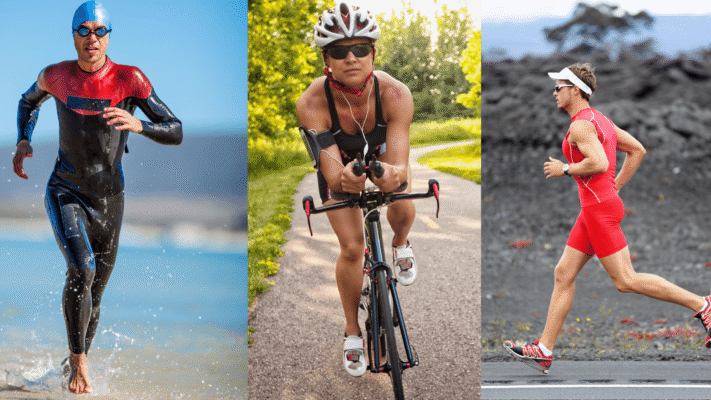posts
How to Balance Swim, Bike, and Run Training Without Burning Out
Introduction
Balancing swimming, cycling, and running — the three pillars of triathlon racing — is both an art and a science. Many athletes, especially beginners, find themselves overwhelmed trying to fit three demanding disciplines into busy schedules. The results are overtraining, fatigue, and, eventually, burnout. But with a structured approach and the right mindset, it’s entirely possible to train effectively for all three sports without losing motivation or energy.
At Tri-n-Win, we know that success in triathlon isn’t just about training harder; it’s about training smarter. Learning how to recover properly, distribute your effort across disciplines, and use the right equipment — from a reliable triathlon racing bike to comfortable triathlon racing shoes and a handy triathlon racing belt — can make the difference between thriving and burning out.
This guide will show you how to strike the right balance: structuring sessions intelligently, monitoring your body’s feedback, and keeping your enthusiasm high as race day approaches. Whether you’re preparing for your first sprint or building towards an Ironman, these practical strategies will help you maintain consistency, prevent injury, and enjoy every part of the process.
Remember, balance isn’t about doing everything equally — it’s about doing what’s necessary to make steady progress while staying healthy. Let’s explore how to find your personal rhythm in the world of triathlon.
1. Understanding the Demands of Each Discipline
Each leg of triathlon racing challenges the body in unique ways. Swimming builds aerobic capacity and upper-body strength, cycling develops leg power and endurance, and running tests efficiency, pacing, and resilience. The key to balancing them is understanding what each discipline contributes — and how much stress it adds to your body.
Swimming, while low-impact, requires technical precision. It’s often best scheduled after hard running or cycling sessions because it promotes active recovery. Cycling sessions on your triathlon racing bike usually demand more time and energy, as they form the aerobic base for the entire race. Long rides should be complemented with shorter interval sessions to build strength without excessive fatigue. Running, on the other hand, delivers the most impact stress. For this reason, fewer but higher-quality runs often produce better results than simply adding mileage.
By assessing your individual strengths and weaknesses, you can allocate your weekly training load intelligently. For instance, if running is your strongest discipline, reduce its frequency slightly to prioritise swim technique or cycling endurance. Conversely, if you’re confident on the bike but weaker in the water, schedule two technique-focused swims per week.
Ultimately, each sport supports the others — but only if balanced. Recognising when to push and when to back off ensures your training complements, rather than competes, across all three segments.
2. Creating a Smart Weekly Training Structure
To succeed in triathlon racing, you need structure — not chaos. A smart weekly plan accounts for energy demands, recovery, and life commitments. It doesn’t mean training every day at full intensity; it means arranging sessions to build consistent, progressive fitness.
A balanced training week might look like this:
- Monday: Swim technique + light strength training
- Tuesday: Bike intervals
- Wednesday: Easy run + swim endurance
- Thursday: Rest or yoga
- Friday: Bike endurance session
- Saturday: Brick session (bike + run)
- Sunday: Long aerobic run or recovery ride
The secret is variety and periodisation. Not every week should look identical. Some weeks build intensity; others focus on recovery. This ebb and flow prevents plateaus and fatigue. Use a training log or smartwatch to monitor heart rate, sleep quality, and effort levels.
Brick workouts (bike-to-run transitions) are particularly effective because they train your legs to handle the shift between disciplines — a common challenge on race day. Practising these regularly helps your body adapt while giving insight into pacing and nutrition.
Finally, be realistic. If you have only five days available, prioritise your weaker discipline, but don’t neglect recovery. Overloading without rest quickly leads to burnout. Training smarter, not longer, keeps you motivated and consistent — the real key to triathlon success.
3. The Role of Recovery and Rest

Recovery is the unsung hero of triathlon progress. While pushing through hard sessions feels productive, it’s the recovery period when adaptation happens — when muscles rebuild, and endurance improves. Without it, you’re simply wearing your body down.
For triathletes, balancing swimming, cycling, and running already creates cumulative stress. That’s why planned recovery days and recovery weeks are essential. A full day off every week (or active recovery through light swimming or yoga) allows the body to reset. Adequate sleep, hydration, and balanced nutrition further support this process.
Your equipment can aid recovery too. A properly fitted triathlon racing bike reduces strain on your back and knees during long rides. Lightweight triathlon racing shoes minimise impact forces while promoting efficient stride mechanics. Even something as small as a triathlon racing belt, keeping your posture free from tugging bibs, adds comfort during long sessions.
Listening to your body is paramount. Watch for early signs of overtraining: irritability, fatigue, or declining performance. Taking an extra rest day is not a setback — it’s smart management. Remember, it’s consistency over months, not one brutal week, that builds triathlon fitness.
4. Balancing Intensity and Volume
A major mistake in triathlon racing is confusing volume with effectiveness. More hours don’t automatically mean better results. Instead, combining varied intensities — endurance, tempo, and interval work — across disciplines creates a complete athlete.
Swim sets should balance technique with intensity: one session focused on form and another on endurance or sprints. On the triathlon racing bike, alternate between steady endurance rides and interval sessions to boost power and aerobic capacity. For running, use a mix of easy runs, hill sprints, and tempo sessions, ensuring at least one complete rest or recovery day per week.
Remember, each workout type stresses the body differently. Two high-intensity sessions back-to-back may leave you drained; instead, follow a hard bike session with an easier swim. This approach — known as “non-competing stress” — keeps fatigue under control while maintaining progress across all three sports.
A good rule of thumb is the 80/20 principle: roughly 80% of your total training should be low-intensity aerobic work, while 20% can be higher-intensity efforts. This proven formula improves endurance without tipping into exhaustion.
Balancing volume and intensity means you’ll arrive at race day fresh, strong, and ready — not overworked and depleted.
5. Maintaining Motivation and Mental Balance
Triathlon training isn’t just physical — it’s emotional and mental. Burnout often starts when enthusiasm fades or when the sport begins to feel like an obligation rather than a passion. To prevent this, set realistic short-term goals and celebrate progress, not just finish lines.
Variety is key. Change routes, join group sessions, or alternate between indoor and outdoor training. These small shifts keep things interesting and reduce mental fatigue. If you enjoy tracking progress, use a training app or journal to note achievements, rest days, and milestones — this creates positive reinforcement and long-term motivation.
Surround yourself with community. The triathlon world is incredibly supportive, both locally and online. Engaging with others who share your goals provides encouragement and accountability. At Tri-n-Win, we see this all the time — athletes who train together stay consistent and inspired.
Finally, remember that balance extends beyond physical effort. Mental recovery is just as vital. Taking a day off to rest, socialise, or simply enjoy life keeps perspective intact. After all, a triathlon should enhance your lifestyle, not consume it.
Final Thoughts
Balancing swim, bike, and run training without burning out is the key to long-term success in triathlon racing. It’s not about cramming in as many hours as possible, but about understanding your body, structuring your sessions, and giving yourself permission to rest. With the right plan, proper recovery, and consistent motivation, you’ll not only reach race day stronger but also enjoy every stage of the journey.
Investing in quality gear supports this balance too. A well-maintained triathlon racing bike ensures comfort and performance on long rides, while dependable triathlon racing shoes protect joints and enhance stride efficiency. Add in a practical triathlon racing belt, and your transitions and race setup become seamless. When your equipment works with you, it frees up energy to focus on what matters — your performance and enjoyment.
Most importantly, triathlon is meant to be sustainable. Avoid chasing perfection or comparing yourself to others. Instead, focus on small, consistent improvements. Over time, those add up to remarkable progress.
At Tri-n-Win, we believe every athlete — beginner or seasoned — deserves to train with confidence and balance. With careful planning, discipline, and the right mindset, you can master all three disciplines, prevent burnout, and cross every finish line with pride and energy to spare.





